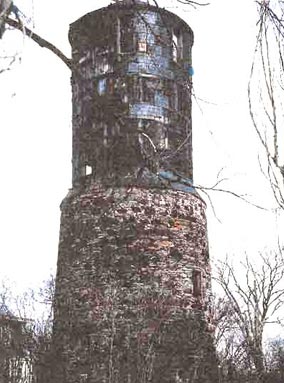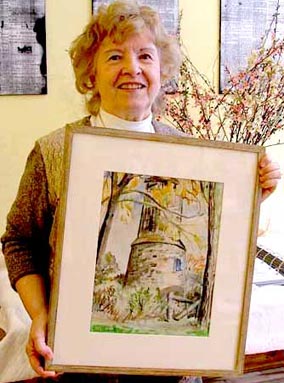The History of the Higginson Observation Tower
The Higginson Observation Tower represents the many positive contributions made by Lieutenant-Colonel Thomas Higginson, an Irish emigrant from County Antrim, Ireland who left for Canada in 1819 and settled in Vankleek Hill in 1829. The Higginson Observation Tower was first constructed by Mr. Thomas Higginson (1794-1884) as a windmill in c. 1830 to serve in the grinding of wheat and corn to further the commercial development of Vankleek Hill and the immediate district. When this project failed due to lack of consistent wind power, Mr. Thomas Higginson, (commissioned Lieutenant in the Prescott Regiment on April 23, 1839) is credited with transforming this windmill into the “first private observatory in Eastern Ontario.”1
Lieutenant-Colonel Thomas Higginson contributed to the social, educational, and spiritual development of Vankleek Hill and the district during the early stages of community formation. He was the second postmaster of Vankleek Hill; the first was Neil Stewart who served when the post office was established in 1827. Both Neil Stewart and Thomas Higginson were the first to represent the district of West Hawkesbury c. 1844 on the newly established district council. “He was Superintendent of Schools for Prescott and Russell, many years, Agent for the Bank of Upper Canada for the transmission of the proceeds of sales of public lands, a member of the County Council.”2
In 1856, the construction of St. John the Apostle Anglican Church was completed on land owned by Lieutenant-Colonel Thomas Higginson. Before the construction completion, Lieutenant-Colonel Higginson was involved in the establishment of a Sunday School that served Vankleek Hill.
The first issue of the weekly news publication The Economist in Vankleek Hill in 1858 was edited by Rupert Mears Wells (later Speaker of the Provincial Legislature) and contained articles and poetry by Lieutenant-Colonel Higginson. From the diaries of Thomas Tweed Higginson, his nephew, comes “March 24, 1858: Economist issued today. Very creditable to V.K.H. Uncle Thomas a Contributor.” On March 31st, another reference is made, “Had a long talk on the 17th article with Uncle Thomas.”3
Lieutenant-Colonel Higginson was the founder of the Mechanic’s Institute in Vankleek Hill in 1857 and its first President. According to diary entries by Thomas Tweed Higginson, for March 30, 1859, “Uncle Thomas preparing a lecture to be delivered before the Mechanic’s Institute: ‘The Change of the Earth’s Surface’.”4 In 1866 in answer to a government call to defend against the Fenian Raid, the Prescott Militia mustered at Lieutenant-Colonel Higginson’s in Vankleek Hill on March 9, 1866, to proceed to Cornwall – “a Fenian Raid anticipated.”5 It is suggested that the Higginson Observation Tower carried out a defensive role during the Fenian Raids as it later carried the term of “look-out” tower.
The Higginson Observation Tower is symbolic of the evolution of 19th-century teaching, learning and civic duty in Vankleek Hill and the district. Colonel William Higginson (1822-1905), son of Thomas, “was appointed Capt. of the first Company of the 18th Batt. of Prescott Volunteer Militia about 1861, commissioned Major 24th July, 1863, and Lieut.-Col. 15th February, 1867.”6 In 1866, Major William Higginson was given command of the volunteer Prescott Militia mustered at Vankleek Hill in anticipation of the Fenian Raid.7 Colonel William Higginson was a “highway surveyor”8 for the Township of West Hawkesbury in 1879 and 1880. He was elected Reeve of this township in 1890 and 1891.9
Colonel Higginson “took an active part in having electric light introduced into the village”10 of Vankleek Hill in the 1890s. According to the diary of his cousin Thomas Tweed Higginson for November 19, 1891: “Vankleek Hill lighted by electricity last night. Great rejoicing.”11 William took an interest in local schooling “and made no little effort to have the High School equipped with a telescope and a good supply of philosophical apparatus.”12 The new railway station to serve Vankleek Hill and the district was on land north of the hill given by Colonel Higginson.
- Higginson, T.B., Descendants of Reverend Thomas Higginson (Research Publishing Company, London) p.16.
- Thomas, Cyrus, History of the Counties: Argenteuil, Quebec, Prescott, Ontario (John Lovell and Son, Montreal 1896) p. 581
- Thomas Boyd Higginson, Diaries of Thomas Tweed Higginson (Research Publishing Company, London 1960) p. 16.
- Ibid. p. 18.
- Ibid. p.20.
- History … Prescott, Ontario, p. 582.
- Diaries, p. 20.
- Minutes of Township of West Hawkesbury, 1879, 1880
- Minutes of West Hawkesbury, 1890, 1891.
- History … Prescott, Ontario, p. 584.
- Diaries, p. 71.
- History … Prescott, Ontario, p. 584.
June 26, 2006: Fenian Raid Medals
The medals pictured were awarded to Major W. Higginson, 18th Battalion and one of his relatives, Private H. Higginson, 18th Battalion. According to Michael McMahon, a part-time dealer in militaria, they were awarded in 1900 to veterans who applied for them and were a morale booster for the Boer War.
In January of 1899, the Canadian Government authorized that a medal be given to men who served in the Imperial or Canadian forces during the Fenian Raids of 1866. As the medal was awarded 29 years later, surviving men had to apply to receive the award. The following requirements had to be proven by the individual applying for the award: he must have been on active service in the field, served as a guard at any point where an attack from the enemy was expected, or been detailed for some specific service or duty.






